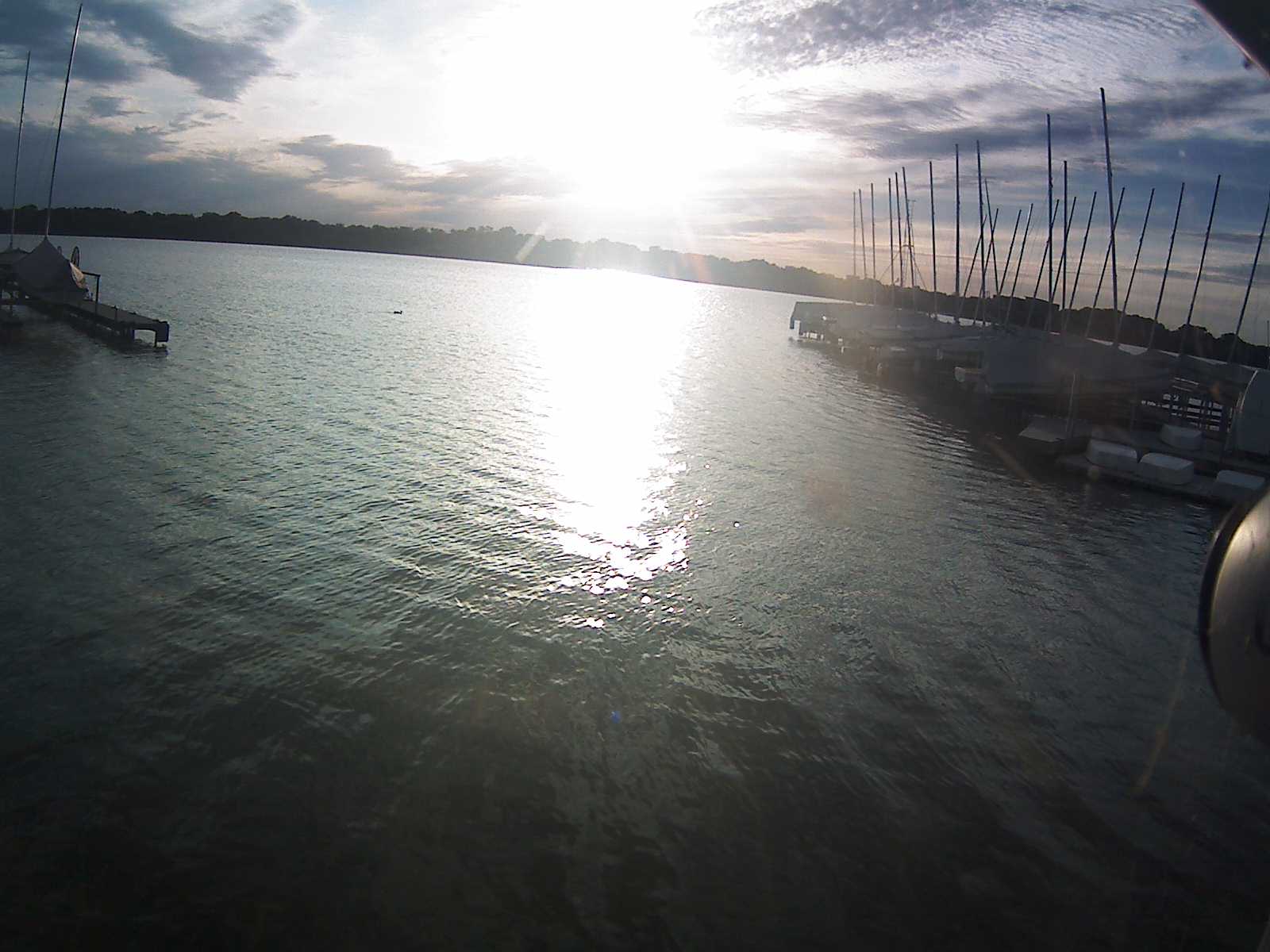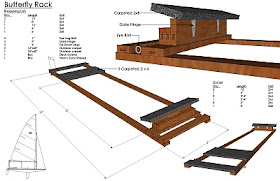Competitive Advantage in a Butterfly
at 4.10.2014
by Pam (and Doug)
With the Butterfly Single-Handed
Nationals coming up, we have heard from various sources that there has been
talk about some boats last year, Doug's in particular, not being one design and
possibly having an unfair competitive advantage. The talk has ranged from a
picture showing Doug's sail with less than a full hoist to speculation about
other ways an old man (he's 62) could have obtained an unfair competitive
advantage to win the event. We're told that this year at the Nationals there
will be an extra push to make sure the boats are all one design. This seems
like a reasonable response to the questions raised.
Many months ago, when we first
heard the rumors about questions about how Doug might have been able to win, I
was amused. The week before the event, he had been competing in the Canadian
Laser Masters where he had come in 2nd. The wind ranged from light and fluky to
howling and the windward legs were a mile long against current. When he arrived
at the Butterfly Nationals, it's safe to say he was about as prepared to do
well as anyone could be. I'm pretty sure that none of the Butterfly sailors
that competed in the Nationals would have come close to 2nd in the Canadian
Laser Masters the week before and yet the speculations of his success aren't
focused on Doug's talent but rather what he might have done to his boat. His
boat was provided to him by the manufacturer and he sailed what he was given. It
seems kind of silly to complain about the boat when the sailor clearly had the
bigger effect, but I sort of get it.
The Dallas fleet has repeatedly
taught me that age and experience beat youth most of the time. I'll admit that
it was a frustrating lesson to learn at first but, over time, I've come to see it
as pure inspiration. Doug mainly sails the Butterfly because of me but he
wouldn't bother if the local fleet didn't provide him with good competition. Which
means the bar is set pretty high in the Butterfly fleet and the boat probably
isn't the factor people should be focused on.
Nonetheless, since the boat is what
is being focused on, I do think Doug has an unfair competitive advantage
because he has enough experience to know which changes to a boat make a
difference and which ones don't. So, in an effort to share his knowledge,
here's Doug telling you exactly what parts of the boat and rigging are
important to him and why.
From Doug:
I was unaware that my sail didn't have a full hoist at the Nationals as
no one mentioned it at the time and, quite frankly, my vision is not the best. I
also do not think that it makes any difference in performance. But being a
strong supporter of one-design sailing, I will make sure that my sail is always
pulled to the very top of my mast.
How could this have been a problem in the first place? I learned in the
70's that main halyards are not your friend. This is one reason why skiffs are
rigged on their side - they lock the head of the main in place so that no
halyard is needed. The reason is that they affect the bending of the mast, and
they create drag exactly where you don't want it and they stretch.
BF rules require a halyard, so I use the thinnest line I can find with
a knot locking at the top so that (1) it does not affect my mast bend and (2)
it creates minimal drag. But if the knot slips past the lock, the sail will
drop by the amount of stretch in the halyard. So, I'm looking for the smallest
pre-stretch line I can find and this should fix the problem.
Here are my opinions on things that might affect BF speed/performance:
- Sails not
raised to the top of the mast. This makes absolutely no difference. Although
I understand some feel it might provide depowering for a light weight sailor
… which I am not.
- Mast shape. I
prefer the older oval style mast shape to the newer round style mast
shape. The oval shape has a lower profile and therefore less drag. As far
as I know both are class legal but I believe the oval mast provides an
advantage.
- More powerful
vang. Not needed, I'd be happy with a 1:1 or 2:1 because the vang is only
needed to control the mast rotation, not the boom position.
- Better
downhaul. Nope, I do not and have never adjusted this.
- Better outhaul.
Nope, not needed.
- Compass. BF's
are designed for small lakes, so getting your bearings is not a problem.
- Better
traveler. Nope. I recently sailed a friend's BF and the traveler was so
loose that the block was 18" off the deck. Speed was not a problem
because of the brilliant mainsheet system pulling the boom down and out.
- Better rudder
shape. The flat plate stalls too easily, but it's the same for everyone so
it's not a factor and should not be changed.
- Better
centerboard shape. No, for the same reason. But this needs an explanation.
I had the great fortune of being mentored by a person who, in many
circles, was the leading expert
on this subject and every high-performance boat in the world has adopted his
designs.
I normally sail a Laser and it's vital to focus on getting lift out of
the centerboard. When it works, it gives you world-class speed. But we do not
sail BF's for speed - we sail them because it's a one-design class and all
boats need to be equal ... even with their flaws. Here's the biggest flaw in a BF.
This shape is very different because (1) it has a bevel around the
outside and (2) the rest is flat. It's horrible because it creates too much
drag, not enough lift, and it stalls way too easily. But, in a one-design class
everyone has the same problem, so it's not a factor and should not be changed.
If you really want a more "modern" shape, don't sail a one-design
boat designed in the 60's.
Subtle shaping of the board would give a sailor a significant and unfair
advantage. A shape closer to the more efficient shape above than the
class-legal shape below that is not mostly flat and where there is no ridge
going into the bevel would be all it took. In my opinion, the class should be
much more concerned about what is happening under the boat than at the top of
the mast.
Every time I've sailed at a Butterfly Nationals, I generally have not
spent any time in the boat I'm sailing and I sail what is provided. In order of
importance, I request the following: clean centerboard, clean hull, oval mast,
light air mainsheet (thin line) and a boat that has all the necessary parts to
be in compliance.
I will be the first to vote in favor of assigning boats randomly before
the first race of a championship event and then switching boats between races. Also,
I try to wear a head cam during races and put them on this and welcome any and all comments
on my setup, racing, and sportsmanship.












4/10/2014 4:25 PM
I always thought you were a rules breaker Peckover. Gimme a break.
4/11/2014 10:35 AM
Two things:
I sail a Bfly because of their design,
it is hard to make them significantly unequal,
but rely on sailor skill.
The Centerboard has always been thought to be an item for improvement.
Fleet 20 (those rebels), several years ago,
outfitted boats with several different boards, including a Laser,
trying to find one that made an improvement.
The flat bottom of the Bfly made slippage angle more of a problem
that made any board shape gain insignificant.
And the experiment was dropped as the rebels gave up.
4/11/2014 11:00 AM
Anon 1 - you've got Doug wondering if you are joking about him being a cheater. Being anywhere near that term doesn't sit well with him.
Anon 2 - very interesting to learn about the Dallas fleet's experiments with the CB. Doug is still swearing that there is an advantage to a shaped board. Since we have a CB to spare, perhaps he'll renew the experiments and pass a shaped board around to see if anyone gets a better performance. As it is, he is always comparing his board to others and thinking they have a better shape than his. When he first started sailing with me, he ran his fingers across my board and had a royal fit since it wasn't smooth and was all chewed up on the edges. He swears a smooth board makes a noticeable difference. Let the experiments begin.
4/11/2014 1:02 PM
Hey we do not want to hear about Doug running fingers across your board....this is a family friendly website right? However I never knew Doug was such a Diva, royal fits huh?
Doug is too funny, we need more like him and less like...
4/12/2014 10:27 AM
It's amazing to me that anyone would question Doug's ethics . . . that is so wrong. Having the sail not pulled to the top would adversely affect performance I would think. Yes, I've heard that recommended for lightweight sailors on windy days. The one time I tried it was a disaster resulting in a capsize. The boom was too high and I had reduced visibility . . . I won't try that again. Let's just admit - Doug is a fantastic sailor!
4/12/2014 10:28 AM
I meant . . . the boom was too low.